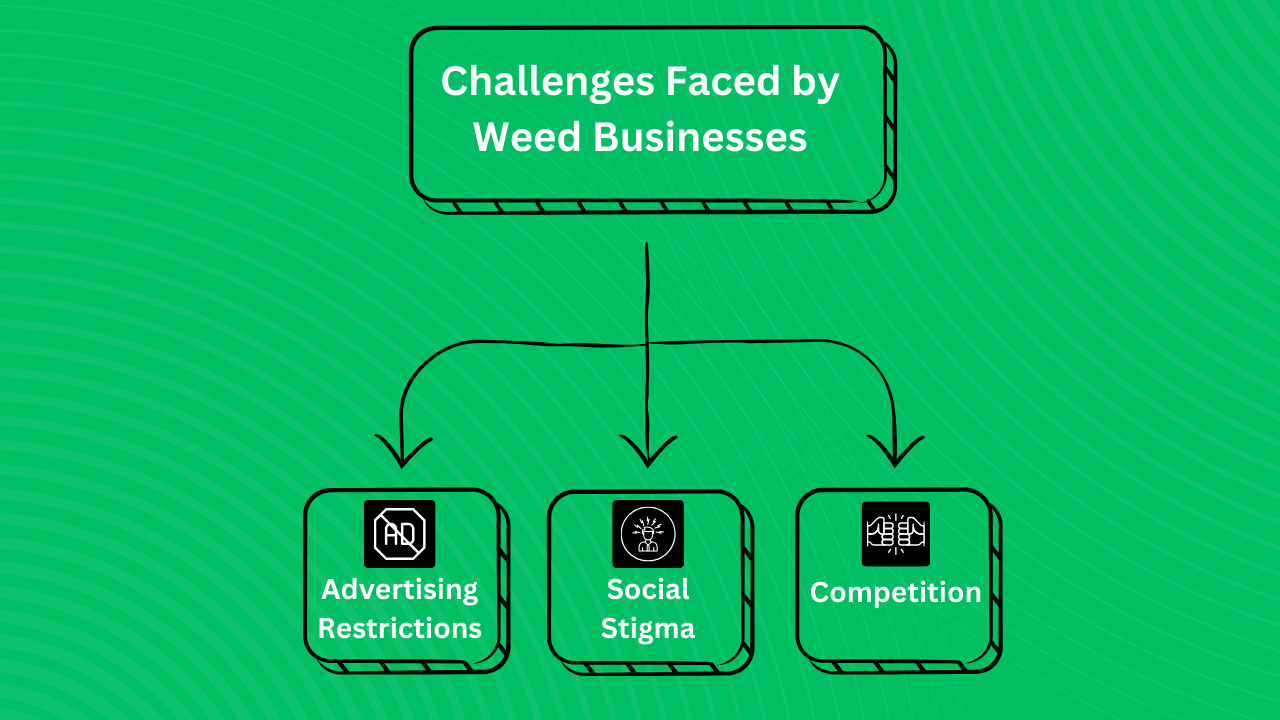Weed Marketing: Strategies and Tactics for Promoting Your Weed Business in 2024
As the cannabis industry continues to grow and evolve, competition within the market is becoming increasingly fierce. To stand out and succeed, weed businesses must employ effective marketing strategies and tactics that help them connect with their target audience. In this in-depth blog post, we will explore various approaches to weed marketing, discuss the challenges faced by weed businesses, and provide insights on how to create a successful marketing campaign in 2024 that will help your business thrive.
“Ignoring online marketing is like opening a business but not telling anyone.” — KB Marketing Agency
Deciphering the Cannabis Market
Before diving into specific marketing strategies for 2024, it’s essential to understand the unique characteristics of the weed market. This industry is highly regulated, with each state having its own set of rules and restrictions. Additionally, there are various types of cannabis products, including flowers, edibles, concentrates, and topicals, each catering to different consumer preferences. To effectively market your weed business in 2024, you must first identify your target audience and understand their needs and preferences. This will help you tailor your marketing efforts to attract and retain customers who are most likely to be interested in your products.
Challenges Faced by Weed Businesses in Marketing

There are several unique challenges that weed businesses face when it comes to marketing their products and services. Some of these challenges include:
A. Competition:
The cannabis industry is highly competitive, with new businesses entering the market every day. This competition can make it difficult for weed businesses to stand out and attract customers.
To overcome this challenge, weed businesses need to focus on differentiating themselves from their competitors and offering unique value propositions to their customers. This may involve:
- Offering a diverse range of products: By offering a wide variety of cannabis products, including flowers, edibles, concentrates, and topicals, weed businesses can cater to the diverse needs and preferences of their customers.
- Providing exceptional customer service: Ensuring that customers have a positive experience when interacting with the business, both online and in-store, can help weed businesses build loyalty and encourage repeat business.
- Emphasizing innovation: Staying up-to-date with the latest trends and developments in the cannabis industry and incorporating new technologies and techniques into their products and services can help weed businesses stay ahead of the competition.
B. Advertising Restrictions:
One of the major challenges faced by weed businesses in marketing is the advertising restrictions imposed by various platforms and government bodies. Many mainstream advertising platforms such as Google Ads, Facebook Ads, and Instagram Ads have strict policies against promoting cannabis-related products, making it difficult for weed businesses to reach their target audience through these channels.
To overcome this challenge, weed businesses need to be creative in their marketing strategies and explore alternative advertising platforms that allow cannabis-related content. These platforms may include:
- Cannabis-specific advertising platforms: There are several advertising platforms that cater exclusively to the cannabis industry, such as My Weed Business, Mantis Ad Network, Traffic Roots, and Puff Digital. These platforms allow weed businesses to reach their target audience without the risk of being banned or censored.
- Content marketing: Creating high-quality, informative content that educates and engages the audience can help weed businesses build brand awareness and establish themselves as trusted sources of information within the cannabis community. Examples of content marketing include blog posts, videos, podcasts, and infographics.
- Email marketing: Building an email list and sending targeted, personalized messages to subscribers can help weed businesses nurture relationships with their audience and drive sales.
C. Social Stigma:
Despite the growing acceptance of cannabis, there is still a significant social stigma surrounding its use and legalization. This stigma can make it difficult for weed businesses to gain the trust and support of potential customers, investors, and partners.
To overcome this challenge, weed businesses need to focus on building a strong brand identity and messaging that resonates with their target audience. This may involve:
- Educating the public: By providing accurate, unbiased information about the benefits and risks of cannabis use, weed businesses can help dispel myths and misconceptions about the plant. This can be achieved through content marketing, social media campaigns, and partnerships with reputable organizations.
- Engaging with the community: Building relationships with local communities and organizations can help weed businesses gain the trust and support of their customers. This may involve sponsoring local events, participating in community initiatives, and supporting charitable causes.
- Emphasizing quality and safety: Ensuring that their products are of high quality and safe for consumption can help weed businesses differentiate themselves from competitors and build trust with their customers. This may involve investing in third-party testing and certification, as well as transparent labeling and packaging.
By focusing on creative marketing strategies, building a strong brand identity, and differentiating themselves from their competitors, weed businesses can overcome these challenges and grow their businesses in a competitive market.
Some Effective Weed Marketing Strategies and Tactics

Now that we have a better understanding of the weed market and the challenges faced by weed businesses, let’s explore some effective marketing strategies and tactics that can help your business succeed in 2024:
A. Content Marketing:
Content marketing is another effective weed marketing strategy that involves creating and sharing valuable, relevant, and consistent content to attract and retain a clearly defined audience. This can help weed businesses build brand awareness, establish themselves as thought leaders in the industry, and drive customer engagement and loyalty.
Some examples of content marketing tactics for weed businesses include:
- Blog posts: Creating informative blog posts that educate readers about cannabis products, strains, and usage can help weed businesses establish themselves as trusted sources of information within the industry.
- Video marketing: Producing high-quality videos that showcase the brand’s products, customer testimonials, and behind-the-scenes footage can help weed businesses engage with their audience and build brand loyalty.
- Social media content: Sharing engaging content on platforms like Instagram, Facebook, and Twitter can help weed businesses build a strong social media presence and foster a sense of community among their followers.
B. Social Media Marketing:
While many traditional advertising channels are not available to weed businesses, social media platforms like Instagram, Twitter, and Facebook can still be powerful tools for connecting with your target audience. Building a strong social media presence and engaging with your followers can create a sense of community and foster brand loyalty.

Some examples of social media marketing tactics for weed businesses include:
- Choosing the right platforms: Identifying the social media platforms where the target audience is most active can help weed businesses focus their efforts on the channels that will yield the best results. This may include popular platforms like Instagram, Facebook, or Twitter, as well as niche platforms that cater to the cannabis community.
- Engaging with followers: Responding to comments, sharing user-generated content, and running contests or giveaways can help weed businesses build a loyal following on social media. This engagement can also help humanize the brand and foster a sense of community among followers.
- Sharing visually appealing content: High-quality photos and videos featuring products, store locations, or behind-the-scenes glimpses can help weed businesses showcase their brand and products in an attractive and engaging way. This content can also help differentiate the brand from competitors and encourage subscribers to share the posts with their own followers.
C. Influencer Marketing:
Influencer marketing involves partnering with influential individuals or organizations within the cannabis industry to promote your brand and products. This can help weed businesses reach a wider audience, build trust and credibility, and drive sales.
Some examples of influencer marketing tactics for weed businesses include:
- Product reviews: Collaborating with popular cannabis bloggers, vloggers, or social media influencers to review your products can help weed businesses gain exposure and credibility within the industry.
- Sponsored content: Partnering with influential cannabis publications or websites to create sponsored content, such as articles, videos, or social media posts, can help weed businesses reach a wider audience and establish themselves as thought leaders in the industry.
- Events and conferences: Participating in industry events and conferences can help weed businesses connect with influential individuals and organizations within the cannabis industry, build relationships, and promote their brands.
D. Event Marketing:
Participating in cannabis industry events and trade shows is a great way to connect with potential customers and showcase your products. By setting up a booth and engaging with attendees, you can generate interest in your brand and drive sales.
Some examples of event marketing tactics for weed businesses include:
- Hosting in-store events: Organizing events such as product launches, workshops, or meet-and-greets can help weed businesses attract customers and generate buzz. These events allow subscribers to interact with the brand and its products in person, fostering a sense of community and loyalty.
- Partnering with local businesses: Collaborating with other businesses in the area can help weed businesses reach a wider audience and build relationships within the community. This could involve co-hosting events, cross-promoting each other’s products, or creating joint marketing campaigns.
- Sponsoring events: Participating in or sponsoring local events, such as festivals or charity fundraisers, can help weed businesses gain exposure and associate their brand with positive causes. This can also provide opportunities for sampling products, distributing promotional materials, and collecting email addresses for future marketing efforts.
E. Email Marketing:
Email marketing is a powerful weed marketing tactic that involves sending targeted, personalized messages to subscribers to nurture relationships and drive sales. This can help weed businesses build customer loyalty, promote new products, and generate repeat business.

Some examples of email marketing tactics for weed businesses in 2024 include:
- Welcome emails: Sending a welcome email to new subscribers can help weed businesses introduce their brand, share their story, and offer exclusive discounts or promotions.
- Newsletters: Regularly sending newsletters to subscribers can help weed businesses keep their audience informed about new products, industry news, and upcoming events.
- Promotional emails: Sending targeted promotional emails to subscribers based on their purchase history, interests, and preferences can help weed businesses drive sales and generate repeat business.
F. Referral Marketing:
Referral marketing is a weed marketing strategy that involves encouraging existing customers to refer their friends and family to your brand. This can help weed businesses build brand awareness, attract new customers, and drive sales.
Some examples of referral marketing tactics for weed businesses include:
- Loyalty programs: Offering rewards or discounts to customers who refer their friends and family to your brand can help weed businesses incentivize referrals and build customer loyalty.
- Social media contests: Running social media contests that encourage users to share your brand with their friends and followers can help weed businesses build brand awareness and attract new customers.
- Word-of-mouth marketing: Encouraging customers to share their positive experiences with your brand through word-of-mouth marketing can help weed businesses build trust and credibility within the industry.
Conclusion
In a nutshell, weed businesses face unique challenges when marketing their products and services. However, by understanding the weed market, identifying your target audience, and employing a combination of effective marketing strategies and tactics, you can create a successful marketing campaign in 2024 that will help your business thrive. Remember to stay compliant with local and federal laws, and always prioritize the needs and preferences of your customers to ensure long-term success in the cannabis industry.


